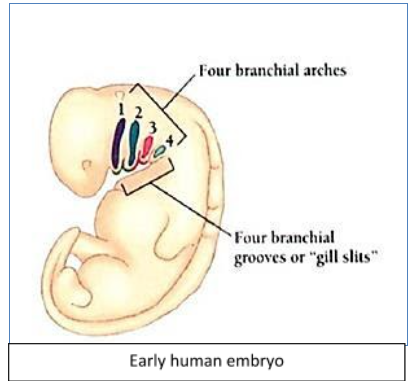
The early human embryo distinctly possesses
A. Gills
B. Gill slits
C. External ear (pinna)
D. Eyebrows
Answer
575.7k+ views
Hint: An embryo is an early stage of development of a multicellular organism. In general, in organisms that show sexual reproduction, embryonic development refers to the portion of the life cycle that starts just after fertilization and continues through the formation of body structures, such as cells, tissues, and organs.
Complete answer: Let us first discuss facts about chordates and human beings: Humans are chordates.
One of the primary and significant characteristic features of chordates is the presence of pharyngeal gill slits. It is not present in adult humans.
Humans are mainly intelligent primates on Earth. The scientific name of humans is Homo sapiens and the systematic position tells us that we are from the phylum Chordata. Chordate animals are characterized by the presence of four distinct structures:
1) notochord
2) pharyngeal gill slits,
3) post-anal tail and
4) dorsal hollow nerve cord.
Humans are Vertebrates and hence the features change a little. For example, the notochord is transformed into a vertebral column. Nerve cord is present dorsally and the post-anal tail is transformed into the reduced vestigial coccyx. But what about the gill slits- those are not present in adults though; still, this structure exists in human early embryos.

So, the correct answer is B. Gill slits
Note: Pinna is not present in humans, not even in the embryos as it has become degenerated over a period of time due to evolution. In the early embryo, eyebrows are also not formed.
Complete answer: Let us first discuss facts about chordates and human beings: Humans are chordates.
One of the primary and significant characteristic features of chordates is the presence of pharyngeal gill slits. It is not present in adult humans.
Humans are mainly intelligent primates on Earth. The scientific name of humans is Homo sapiens and the systematic position tells us that we are from the phylum Chordata. Chordate animals are characterized by the presence of four distinct structures:
1) notochord
2) pharyngeal gill slits,
3) post-anal tail and
4) dorsal hollow nerve cord.
Humans are Vertebrates and hence the features change a little. For example, the notochord is transformed into a vertebral column. Nerve cord is present dorsally and the post-anal tail is transformed into the reduced vestigial coccyx. But what about the gill slits- those are not present in adults though; still, this structure exists in human early embryos.

So, the correct answer is B. Gill slits
Note: Pinna is not present in humans, not even in the embryos as it has become degenerated over a period of time due to evolution. In the early embryo, eyebrows are also not formed.
Recently Updated Pages
Master Class 12 Business Studies: Engaging Questions & Answers for Success

Master Class 12 Economics: Engaging Questions & Answers for Success

Master Class 12 English: Engaging Questions & Answers for Success

Master Class 12 Maths: Engaging Questions & Answers for Success

Master Class 12 Social Science: Engaging Questions & Answers for Success

Master Class 12 Chemistry: Engaging Questions & Answers for Success

Trending doubts
What is meant by exothermic and endothermic reactions class 11 chemistry CBSE

Which animal has three hearts class 11 biology CBSE

10 examples of friction in our daily life

One Metric ton is equal to kg A 10000 B 1000 C 100 class 11 physics CBSE

1 Quintal is equal to a 110 kg b 10 kg c 100kg d 1000 class 11 physics CBSE

Difference Between Prokaryotic Cells and Eukaryotic Cells




